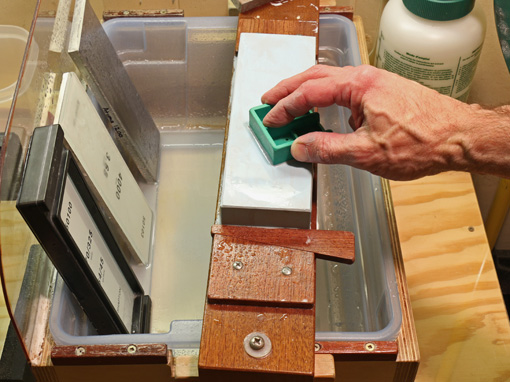
Several reasons are usually given for using a nagura on fine grit waterstones. These include: to raise a slurry, to remove unwanted deposits in natural Japanese stones, to refresh the cutting surface of the stone, and to flatten areas of the stone.
Let’s think about what’s going on when a nagura is used, recalling what we can directly sense at the sharpening bench.
The slurry
When the little nagura stone is rubbed on the finishing stone, a paste, or slurry, is generated. It is sometimes claimed that the slurry actually does the sharpening, but it seems questionable whether loose abrasive particles in the slurry are really cutting steel. There are microscopic photographs of blade edges and stone surfaces, but to my knowledge, no direct visual recording of the actual cutting action at a microscopic level. We can observe the effects but not the actions that produced them.
The thin edge of steel plows most of the slurry but perhaps some loose particles are held by the stone’s surface texture, enabling them to cut. Maybe it burnishes the steel. Maybe it creates a variable grit surface on a synthetic stone somewhat like in a natural stone.
In any case, we can sense that the slurry improves the feel and ride of the blade on the stone and reduces sticking, all helpful effects. So, whatever it is actually doing, the slurry at least feels good.
The next issues are what composes the slurry and what happens to it.
Are there particles of the finishing stone, the nagura stone, or both in there? Particles of the softer (more loosely bound) of the two stones will presumably predominate. This should be considered when the two differ in grit size. For example, a nagura that is softer and coarser than the synthetic waterstone with which it is paired will be probably be counterproductive.
With fine natural Japanese waterstones, nagura selection is an art unto itself. Consult a knowledgeable purveyor of these stones. The nagura also is used to remove defects in natural stones that can damage the blade edge. This function is, of course, not relevant for synthetic stones.
So, what happens to the particles in the slurry? Are they left intact or crushed to some degree? If the nagura could crush loose grit to a finer size, that would seem to be an advantage assuming these crushed particles retained their cutting ability.
The surface of the stone
We can see and feel that a nagura refreshes the surface of the stone by removing metal and glazing. Much like dressing a grinding wheel, cutting particles are better exposed at the surface, ready to cut steel.
As for flattening, there are better ways to do this accurately than with a nagura, though with natural stones a nagura might be helpful for some local flattening as it is used intermittently for its other benefits in the course of sharpening.
A solution
There may be more questions than answers here and you may be thinking that this is all a little bit interesting but enough already. I agree, I’d rather get back to woodworking. However, at least restricting the matter to synthetic waterstones, which most woodworkers use, there is a simple solution to all of this, to be discussed in the next post. The background discussion of this post will support why I think the solution makes so much sense.


Working as a supplier to the mining industry, I can assure you that we have evidence that slurry alone can cut steel, even harder (but more more brittle) steels than those used in hand tools. But I agree that most of it’s advantage come from the feel and the stone (or slurry trapped against the stone) does more of the cutting.
Interesting, Rob. These are questions that have occurred to me, too. I’m looking forward to reading about the solution you’ve come up with.
Rob,
If you have a few hours to spare, you might consider hopping over to one or two of the more popular straight razor forums and read through their discussions on whether or not one should slurry the fine finishing stone when honing.
It’s the pins vs. tails of straight razor shaving.
But there is also a lot of knowledge in those forums, so you might find something helpful for this discussion!
Thanks, Mark. Interesting.
Thanks, Tico.
Ethan, haha, only a few hours? I visited some sharpening and stone sites, and discussions. It can get a bit crazy.
Rob